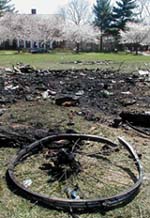|
|
|
|
|
Politics
|
|
Officials Say Student Sports Rioting Is More Violent, More Commonplace
By Catherine Dolinski WASHINGTON - You win some, you lose some, you riot either way.
Such has been the trend in recent years on college campuses after
big-time athletic events like the NCAA Men's Basketball Tournament. And
no one has demonstrated it better than fans at the University of
Maryland, College Park, where thousands faced off with hundreds of police
Monday after the Terrapins won the national championship.
Post-game bedlam like that has been erupting on campuses around the
country, leaving police and college officials scrambling to implement new
security measures to break the cycle, which they say has been growing more
violent, and more commonplace.
"This is a trend, but not just at College Park. It's a national
phenomenon," said Maj. Cathy Atwell, of the College Park campus police.
"It's been increasing over the last two years or so."
The raucous scenes Monday along Route 1 in College Park -- bonfires,
looting, drunken brawls, flying beer bottles and walls of troopers in riot
gear -- were still milder than damage Terp fans caused last year after
losing to Duke in the NCAA Final Four.
In Arizona, Tucson Police Sgt. Marco Borboa said he had flashbacks
when he saw pictures of the College Park mob scene in Tuesday's
newspapers.
"Those photos could've been taken here," he said.
The chaos Borboa remembers followed the University of Arizona's NCAA
championship loss to Duke last spring. That night, rowdy Wildcats fans
smashed out storefronts, attacked police, set fire to trash cans and even
burned a mobile home.
The episode, which resulted in at least 17 arrests, replayed many of
the same problems the city suffered when Arizona beat Kentucky to win the
championship in 1997.
"This year we had no incidents, but it looks like other campuses are
being faced with it now," Borboa said. "The problem is that it becomes a
tradition. Once you have one or two incidents, it becomes the tradition
that this is the place to gather, and that becomes well-known. It's tough
to break the cycle."
Atwell pointed to similar problems in recent years at universities
like Michigan State and Ohio State. "Even Indiana had some unrest last
night," she said Tuesday.
Bloomington, Ind., police reported that after the Hoosiers lost to the
Terps Monday, a crowd of thousands of Indiana fans grew unruly, throwing
bottles, ripping plywood off buildings and lighting fires. About 1:30
a.m., the roughly 130 riot gear-clad city and state troopers in downtown
Bloomington resorted to using tear gas and pepper spray to disperse the
mob.
Lt. Jerry Minger, of the Indiana University campus police, said most
of the rabble-rousing occurred downtown, and that things had stayed
comparatively peaceful on campus. Yet even campus cops wound up making
about 20 arrests that night, adding to the 10 or 15 reported by city
police.
"Part of this is a copy-cat phenomenon," said Sheldon Steinbach,
general counsel for the American Council on Education.
Steinbach, who has observed student riot behavior for several decades,
said campus sports rioting traces back to high-profile episodes of
violence following professional sports games like the World Series,
Stanley Cup and the Superbowl.
"It sets up a pattern for other revelers to mimic," he said.
"Reactions in various towns for professional sports events have set the
pattern. . . . It's behavior fueled by excessive alcohol consumption, and
with that comes somewhat of a herd mentality."
Jeff Kretschmar, of the Miami University Sport Fan Research group in
Ohio, agreed, noting that young people often learn the ins and outs of
mob behavior from television.
"After the game, you get people outside in a group who've been
drinking all day, feeling cohesion in the group," Kretschmar said. "What
happens is, the person in the group feels anonymous, and their actions
feel unidentifiable. So they feel more free to do these things."
For that reason, police are wise to start using video surveillance of
crowds to "wake up" fans from their mob mentality, he said.
Borboa said police in Tucson and other university towns are starting
to observe one another and trade tips about crowd control in preparation
for the next unruly event.
"We're all trying to learn what works -- and what doesn't," he said.
George Cathcart, spokesman for the University of Maryland, College
Park, said colleges are fine-tuning their responses as well. College Park
recently expanded its code of conduct to allow students to be disciplined
for misdemeanors committee off-campus. Previously, only off-campus
felonies were covered.
Cathcart said he was optimistic that more and more students are
rejecting the riot tradition. He admitted, however, it's still a
liability that comes with increased success and attention in school
sports. Having also sent its football team to the Orange Bowl this year,
the College Park campus has had its share of problems with disorderly
crowds lately.
"It happens at schools with really good sports teams," Cathcart said.
"But it's certainly not a badge of honor any of us want to wear."
Copyright ©
2002 University
of Maryland College of Journalism
|








